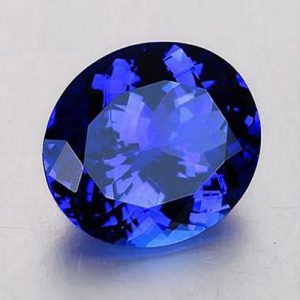Tanzanite
TanzaniteThe name “Tanzanite” is a tradename, not an officially recognized mineral. It was named in the 1960’s by Tiffany and Company after Tanzania, its country of origin. It is a variety of Zoisite which is a member of the Epidote group of minerals that includes Allanite, Clinozoisite, Epidote, Hancockite, Mukhinite, Piemontite, Tanzanite, Thulite and Zoisite. It has become the most popular gemstone after Diamond, Ruby, Sapphire and Emerald.
The gem Tanzanite is the result of (usually) heating green to brown Zoisite to about 500 – 600 degrees Farenheit. When this occurs, the greenish to brownish Zoisite transforms into the characteristic intense blue with violet dichroism of Tanzanite. Unheated Zoisite gems are available in shades of green, yellow, brown, gold, pink, and very rarely blue or violet. Tanzanite is strongly dichroic, showing different shades of blues and violets depending on lighting conditions and viewing angle. It will show the most blue under daylight and more violet under incandescent light. Despite its popularity in jewelry, Tanzanite is a relatively soft and brittle gem and should be worn with care.
It is believed that Tanzanite was first discovered by the Masai tribe in the Merelani Hills in northern Tanzania after a grass fire changed the brownish Zoisite crystals on the ground to blue-violet. Then in the 1960’s a Portuguese geologist named DeSouza brought these blue-violet crystals to the attention of Tiffany and Company. Until recent very small finds in Kenya, the only source of Tanzanite was the Merelani Hills, Umba Valley, Lelatema Mountains, Arusha Region in northern Tanzania.
| Chemical Formula: | Ca2Al3Si3O12(OH) |
| Calcium Aluminum Silicate Hydroxide | |
| Molecular Weight: | 454.36 gm |
| Composition: | Calcium | 17.64 % | Ca | 24.68 % | CaO |
| Aluminum | 17.82 % | Al | 33.66 % | Al2O3 | |
| Silicon | 18.54 % | Si | 39.67 % | SiO2 | |
| Hydrogen | 0.22 % | H | 1.98 % | H2O | |
| Oxygen | 45.78 % | O | |||
| 100.00 % | 100.00 % | = TOTAL OXIDE | |||
| Crystallography: | Orthorhombic – Dipyramidal |
| Crystal Habit: | Crystals prismatic, to 10 cm, typically deeply striated || [010] and poorly terminated; columnar to compact, massive. |
| Twinning: | None |
| Color: | Blue, Purple, Green |
| Transparency: | Transparent to Translucent |
| Luster: | Vitreous, Pearly |
| Refractive Index: | 1.692 – 1.700 Biaxial ( + ) |
| Birefringence: | 0.009 |
| Dispersion: | 0.019 |
| Pleochroism: | Strongly Trichroic; X = pale pink to red-violet; Y = nearly colorless to bright pink or deep blue; Z = pale yellow to yellow-green. |


